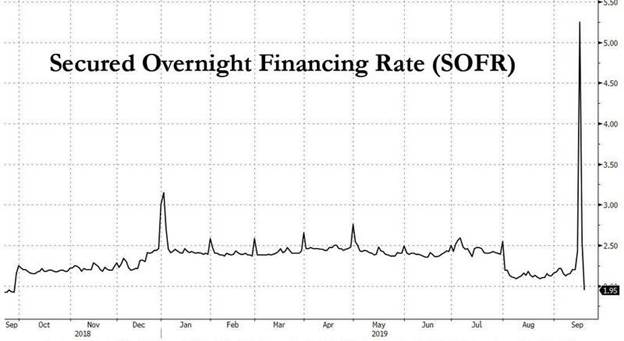|
Last month we saw some more wizardry by central banks, this time in REPO markets. This has prompted us to consider two things, first, how many people actually know what the REPO market is? Secondly, does this mean we are heading for some more good ol' fashioned QE? This week we would like to take a closer look at what happened last month in the US REPO markets. What is the REPO market I hear you ask? For simplicity, we will use the Washington Post’s definition:
The REPO markets are seen as vital to the provision of credit in the banking sector. So what happened last month? Well simply put, and as can be seen below, the markets vomited. Whereby the rate at which money markets and dealers were willing to finance even shorter-term lending shot up overnight. Eventually, this led to the Federal Reserve as the lender of resort to step in and pump approximately $75bn in an auction that was oversubscribed (meaning that the banks required approximately $95 billion in shorter-term liquidity to keep operations from keeling over). More than a decade after the last liquidity squeeze that we all remember, the fact that the financial system in the US still requires the Federal Reserve for liquidity injections is something that we will leave up to the judgement of the readers. What is rather concerning about this whole scenario though is that this essentially means that dealer banks are willing to pay a premium to hold treasury bills rather than pass on the liquidity. To put it in plainly, US treasuries are at the top of the hierarchy when it comes to perceived safe-haven assets and are almost a requirement when it comes to tier-one capital or liquidity management. Given its backing by the US government and the US treasury, it is considered a risk-free asset. Hence dealers (borrowers) can easily sell the treasuries to lenders in the REPO market. The market works because they agree to buy the collateral or the treasury’s back the next day with a small interest payment. But what happens if the lenders decide to stop and hoard their treasuries? Preferring to make 1.8% on their reserves at the Federal Reserve rather than lend, no matter the interest. This, unless they’re worried about something, sounds illogical, doesn’t it? Unfortunately, this is exactly what happened starting on the 18th of September and not many people understand exactly what happened. The mainstream explanation appears to be, including from Powell, that they were technical factors that aren’t too important. Including that corporations required a substantial amount of dollars to meet their quarterly tax commitments and the Treasury required an additional $100bn to meet its shorter term requirements. If that were the case it would be rather baffling, given the seasonality and repetitive nature of the process every year, if everyone in the market had decided to turn a blind-eye and not worry about making sure there was any liquidity in the system. Something tells us there was something else behind this. One explanation could be the tax cuts in 2017 which blew out the budget deficits (dealer banks who are forced to buy and hold the inventory of new treasuries) were sucking up the liquidity from the system. Alternatively, dealer banks are hoarding treasuries because they see some problems which they are not making the rest of us aware of. We think the latter is the more likely scenario at least in the short-run. So what does this have to do with QE? Well, on the one hand, we should be quite worried that there is something fundamentally wrong with the liquidity and global credit conditions. On the other hand, we should also be rejoicing. The very nature of the Federal Reserve’s reaction tells us all we need to know about the willingness of the central bank to throw whatever is necessary at the wall to make sure the markets are happy, who cares if they seemingly do not understand what exactly is going on and whatever the scale and cost. It has come a long way since the early days of Powell, suggesting that he was not there to act as a caretaker to the markets. At this stage, it seems the Federal Reserve’s job is to go so far as to pre-emptively save the markets.  The underlying US economy seems to be on relatively safe footing despite the doom and gloom. Despite this, the risks in the financial sphere have seemingly highterned nevertheless. Of course, we can feel safe in the knowledge that Sheriff Powell is out there vigilantly watching over us, a nice hand-out ready in his six-shooter every time a liquidity event rolls through town. And yes, even though the S&P 500 is a stone’s through away from all-time highs, the current intervention in the REPO market, according to mandate, extends to the 10th of October. After which time the regulator will ‘continue to watch the indicators closely and intervene as necessary’. All this to say, using one of our favourite sayings, ‘public risk and privatised profit.’ Our prediction is that there will be another round of QE as the Fed moves towards 0-bound interest rates in Q4. This makes it a bull case for equities (though the caveat is what happens between now and then), if the liquidity events keep going in the same direction we might see continued volatility. That being said, remember all the noise around the yield curve. If there is a continued squeeze on liquidity and there is a shortage of shorter-term T-Bills, this isn’t necessarily the indicator to watch in terms of future recession signs and even if it was, as we have previously elaborated on, asset class returns (especially equities) have nothing to do with underlying economic growth or fundamentals which are going to continue to be exceptionally disjointed. It also means that despite the low yields, Treasuries and debt instruments will continue to rally. All this at a time when pension funds and the institutional allocators continue to move up the risk curve. This is especially the case as the portfolio managers who have nominal targets increasingly allocate towards increasingly riskier (in terms of their gradings) assets. This points towards a continuation of the bull-run across both defensives and cyclical’s. We are by no means suggesting that this is all there is to it but continued central bank interference will, we think, have a continued substantive impact on asset valuations across the board.
0 Comments
Your comment will be posted after it is approved.
Leave a Reply. |
Markets & CommentaryAt TAMIM we are committed to educating investors on how best to manage their retirement futures. Sign up to receive our weekly newsletter:
TAMIM Asset Management provides general information to help you understand our investment approach. Any financial information we provide is not advice, has not considered your personal circumstances and may not be suitable for you.
Archives
April 2024
Categories
All
|
TAMIM | Equities | Property | Credit
DISCLAIMER
The information provided on this website should not be considered financial or investment advice and is general information intended only for wholesale clients ( as defined in the Corporations Act). If you are not a wholesale client, you should exit the website. The content has been prepared without taking into account your personal objectives, financial situations or needs. You should seek personal financial advice before making any financial or investment decisions. Where the website refers to a particular financial product, you should obtain a copy of the relevant product services guide or offer document for wholesale investors before making any decision in relation to the product. Investment returns are not guaranteed as all investments carry some risk. The value of an investment may rise or fall with the changes in the market. Past performance is no guarantee of future performance. This statement relates to any claims made regarding past performance of any Tamim (or associated companies) products. Tamim does not guarantee the accuracy of any information in this website, including information provided by third parties. Information can change without notice and Tamim will endeavour to update this website as soon as practicable after changes. Tamim Funds Management Pty Limited and CTSP Funds Management Pty Ltd trading as Tamim Asset Management and its related entities do not accept responsibility for any inaccuracy or any actions taken in reliance upon this advice. All information provided on this website is correct at the time of writing and is subject to change due to changes in legislation. Please contact Tamim if you wish to confirm the currency of any information on the website.
magellen, kosec, clime, wilson, wam, montgomery, platinum, commsec, caledonia, pengana, tamim


 RSS Feed
RSS Feed